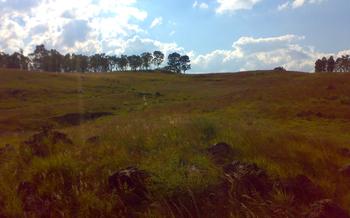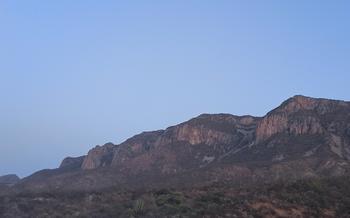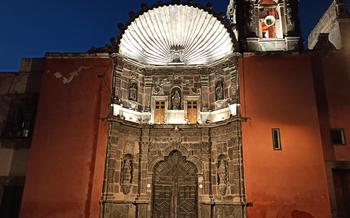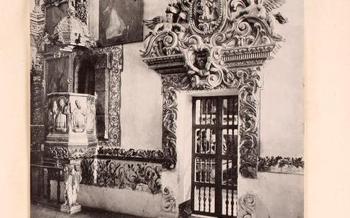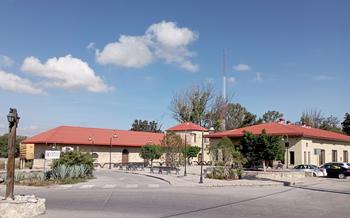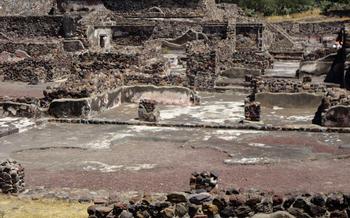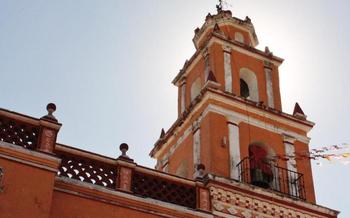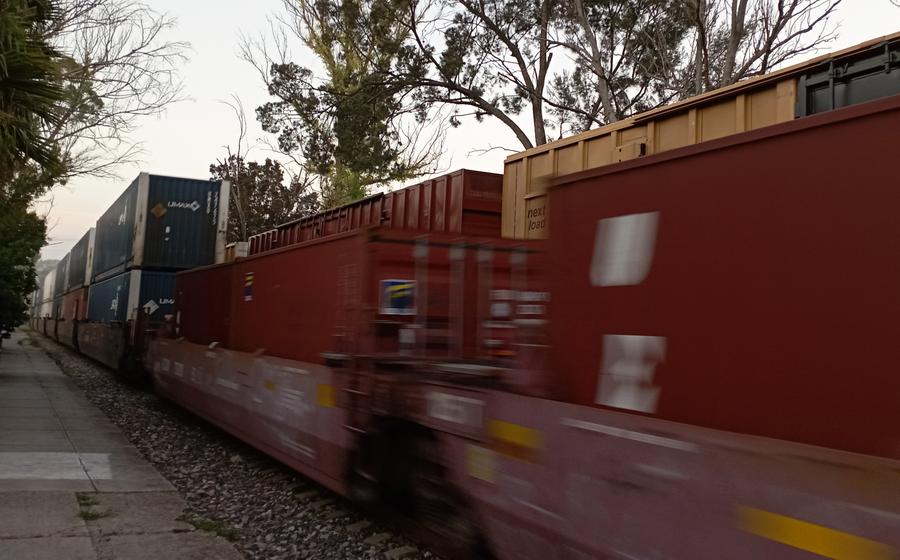
Canada de la Virgen Archaeological Site
- Ancient History of the Site
- Location and Getting There
- Entrance Fees and Hours of Operation
- What to Expect at the Site
- Exploring the Archaeologico-Ecological Park
- The Great Pyramid
- The Ball Court
- The Temple of the Cross
- The Temple of the Skulls
- The Museum
- Guided Tours
- Photography and Videography
- Accessibility
- Tips for a Memorable Visit
- Insider Tip: Unveiling Hidden Gems
Ancient History of the Site
In the heart of Mexico, where the Sierra Madre Oriental mountains cast long shadows, lies the enchanting city of San Miguel de Allende, a UNESCO World Heritage Site brimming with colonial charm and rich history. Just a stone's throw away, nestled amidst rolling hills and lush vegetation, is the Canada de la Virgen Archaeological Site, an enigmatic window into Mexico's pre-Hispanic past.
The Canada de la Virgen site, believed to have been inhabited as early as 1000 BCE, showcases the remarkable legacy of the Otomi people, who flourished in this region long before the arrival of the Spanish conquistadors. These skilled artisans, farmers, and traders left behind a treasure trove of archaeological wonders, including towering pyramids, intricate ball courts, and sacred temples, all whispering tales of a sophisticated and vibrant civilization.
As the centuries unfolded, the Otomi people's influence waned, and the site was gradually abandoned, its secrets swallowed by the jungle's embrace. Time stood still, preserving the ruins beneath a blanket of vegetation until the late 19th century when intrepid archaeologists stumbled upon this hidden gem, revealing the splendor of a lost civilization to the world.
Location and Getting There
The Canada de la Virgen Archaeological Site is situated roughly 8 kilometers northwest of the bustling city of San Miguel de Allende, in the state of Guanajuato, Mexico. This ancient site, nestled amidst the picturesque landscapes of central Mexico, is easily accessible by road, making it a popular destination for history and nature enthusiasts alike.
To reach the archaeological site, you can either embark on a scenic drive or take advantage of the convenient public transportation options available. If opting for a self-drive, follow the highway signs leading to the town of Atotonilco, then take a detour onto a well-maintained dirt road that will guide you directly to the site. Alternatively, you can hop on a local bus from San Miguel de Allende, which offers a hassle-free and budget-friendly mode of transport.
Once you arrive, you will find ample parking spaces designated for visitors, ensuring a smooth and stress-free start to your exploration of this captivating historical site.
Entrance Fees and Hours of Operation
To visit the Canada de la Virgen Archaeological Site, you'll need to purchase an entrance ticket. The current admission price for international visitors is 80 pesos (approximately 4 USD). Children and students with valid IDs can enjoy a discounted rate of 40 pesos. The site is open to the public from Tuesday to Sunday, from 9:00 AM to 5:00 PM. It's worth noting that the site may be closed on certain holidays, so it's advisable to check the official website or contact the local tourism office for the most up-to-date information.
When planning your visit, consider the best time to explore the site. The early morning hours or late afternoon are ideal to avoid the midday heat and crowds. If you're visiting during the summer months, remember to bring water, sunscreen, and a hat to protect yourself from the sun. It's also a good idea to wear comfortable shoes as you'll be doing a lot of walking on uneven terrain.
What to Expect at the Site
As you approach the site, you'll be greeted by a sprawling landscape dotted with archaeological treasures. The main attraction is the Great Pyramid, an iconic symbol of Cañada de la Virgen. Towering over the surroundings, it's an awe-inspiring sight that will leave you in awe.
Take your time to explore the pyramid's intricate architecture and marvel at its impressive size. Climb to the top for breathtaking panoramic views of the surrounding valley. The views from the summit are simply stunning, offering a bird's-eye perspective of the entire archaeological site and the picturesque countryside beyond.
In addition to the Great Pyramid, be sure to visit the Ball Court, a significant feature of ancient Mesoamerican cities. Here, you can learn about the importance of the ball game in ancient cultures and witness the impressive dimensions and layout of the court.
The Temple of the Cross is another must-see sight, known for its unique characteristics and religious significance. Admire the intricate carvings and symbolism of the cross, a powerful symbol in Mesoamerican cultures.
Don't miss the Temple of the Skulls, a fascinating structure with distinctive features and a mysterious purpose. Explore the symbolism of skulls and their placement within the temple, and learn about the ongoing archaeological research and excavations that continue to shed light on its history.
Exploring the Archaeologico-Ecological Park
The Canada de la Virgen Archaeological Site is nestled within a beautiful and diverse natural landscape, known as the Archaeologico-Ecological Park. This park encompasses a variety of ecosystems, including grasslands, forests, and wetlands, all teeming with wildlife. Visitors can immerse themselves in the natural beauty of the site while exploring its ancient history.
One of the best ways to experience the park is by taking a guided tour. Knowledgeable guides will lead you through the park, pointing out the different plant and animal species and sharing stories about the site's history. You can also choose to explore the park on your own, following the well-marked trails. Keep an eye out for birds, reptiles, amphibians, and mammals that call the park home. The park is a birdwatcher's paradise, with over 200 species recorded, including migratory species that visit during the winter months.
For those interested in learning more about the park's natural history, there is a small museum located near the entrance. The museum displays exhibits on the park's geology, flora, and fauna, as well as artifacts found during archaeological excavations.
The Great Pyramid
The Great Pyramid is the centerpiece of Canada de la Virgen and one of the largest and most impressive structures in the archaeological site. It is believed to have been constructed between the 12th and 15th centuries and served as a significant religious and ceremonial center for the indigenous people. The pyramid is constructed of large stone blocks, some of which weigh several tons, and features a stepped design with a series of platforms leading to a temple at the summit.
The pyramid's unique architectural features and design set it apart from other pyramids in the region. It has a wider base and a steeper incline than most, giving it a more imposing appearance. The pyramid also features a series of terraces and platforms, which may have been used for agricultural purposes or for religious rituals.
One of the highlights of a visit to Canada de la Virgen is the opportunity to climb to the top of the Great Pyramid. The climb is challenging but rewarding, offering panoramic views of the surrounding landscape. From the summit, visitors can admire the vast expanse of the archaeological site, the lush vegetation, and the distant mountains.
The Ball Court
The ball court at Canada de la Virgen is a testament to the importance of the ball game in ancient Mesoamerica. This ancient sport, known as tlachtli, was not just a game but a ritual with deep religious and symbolic significance. The court is an impressive rectangular field, measuring approximately 65 meters in length and 10 meters in width. It is constructed with sloping sides and two large stone rings, one on each side of the field. These rings, known as tlachtemalacatl, served as goals for the game.
The ball game was played with a solid rubber ball, which was hit with the hips, elbows, or knees. The objective was to keep the ball in play and to score points by hitting the ball through the stone rings. The game was often played between two teams, each representing a different community or social group. The outcome of the game was believed to have religious and political implications, and the winning team was often rewarded with prestige and honor.
The Temple of the Cross
Amidst the ruins of Canada de la Virgen, the Temple of the Cross stands as a testament to the religious beliefs and practices of the ancient inhabitants. This unique structure derives its name from the prominent cross carved into its facade, a symbol that has captivated the imagination of archaeologists and visitors alike. The cross, a symbol commonly associated with Christianity, has been interpreted as a representation of the four cardinal directions or as a symbol of the sun, revered by many Mesoamerican cultures.
The Temple of the Cross showcases a blend of architectural styles, reflecting the fusion of different cultures that influenced the region throughout history. Its intricate carvings and elaborate designs suggest its significance as a religious center, possibly dedicated to a specific deity or deities. Archaeologists have discovered various offerings and artifacts within the temple, providing insights into the rituals and ceremonies that took place within its sacred walls.
Although much of the temple's history remains shrouded in mystery, the Temple of the Cross continues to captivate visitors with its unique symbolism and architectural features. It stands as a reminder of the complex and diverse religious beliefs that shaped the ancient civilizations of Mexico.
The Temple of the Skulls
Among the many structures within the Canada de la Virgen Archaeological Site, the Temple of the Skulls stands out as one of the most intriguing and macabre. Its name derives from the numerous human skulls and bones discovered during excavations, suggesting its use as a ritual site dedicated to death and sacrifice.
The temple's unique architectural features and symbolism have captivated archaeologists and historians alike. Its walls are adorned with intricate carvings and reliefs depicting various skeletal figures and deities associated with the underworld. The temple's interior reveals a central altar where offerings and sacrifices were likely made, surrounded by niches and chambers that may have served as burial chambers or storage for ritual objects.
Ongoing archaeological research at the Temple of the Skulls continues to shed light on its significance and the ancient rituals performed within its walls. Excavations have uncovered a wealth of artifacts, including ceramic vessels, stone tools, and jewelry, providing valuable insights into the beliefs and practices of the site's inhabitants.
Visitors to the Canada de la Virgen Archaeological Site are invited to explore the Temple of the Skulls and contemplate its eerie beauty. This enigmatic structure serves as a powerful reminder of the complex and fascinating mortuary practices of ancient Mesoamerican civilizations.
The Museum
In close proximity to the archaeological site, visitors can delve into the history and significance of the Canada de la Virgen Archaeological Site at the on-site museum. This treasure-trove of knowledge houses an array of artifacts unearthed during excavations, providing a tangible connection to the past. These artifacts, each with its own story to tell, offer insights into the daily lives, rituals, and beliefs of the ancient inhabitants of this sacred place.
The museum's exhibits are thoughtfully curated, taking visitors on a chronological journey through the site's history. From the earliest settlements to the zenith of the Toltec civilization and its eventual decline, the exhibits provide a comprehensive narrative of this ancient metropolis. Visitors can marvel at intricate pottery, finely carved stone sculptures, and a myriad of other artifacts that attest to the artistic prowess and craftsmanship of the Toltec people.
In addition to the artifacts, the museum also features informative displays that delve into the cultural and religious significance of the site. Through interactive exhibits, visitors can learn about the complex mythology of the Toltecs, their agricultural practices, and their unique system of writing. The museum's curators have skillfully crafted an immersive experience that brings the ancient world to life, allowing visitors to connect with the past in a truly meaningful way.
Guided Tours
Enhancing your visit to Canada de la Virgen Archaeological Site is made possible by joining a guided tour. Knowledgeable and experienced guides bring the site's history and significance to life, providing insights into the ancient civilizations that once thrived here. Tours are typically offered in Spanish, but English-speaking guides are available upon request, ensuring that international visitors can also delve into the rich cultural heritage of the site.
The cost of guided tours varies depending on the group size and the duration of the tour. It is recommended to book your tour in advance, especially during peak tourist season, to secure a spot and avoid disappointment. Online booking platforms and local tour operators offer a range of guided tour options, catering to different interests and budgets.
Whether you prefer a comprehensive overview of the site or a more in-depth exploration of specific areas, guided tours offer a personalized and enriching experience. Guides can tailor the tour to your interests, highlighting hidden details and sharing fascinating stories that bring the site's ancient past to life.
Photography and Videography
Photography and videography enthusiasts will find Canada de la Virgen a treasure trove of captivating subjects. The ancient ruins, dramatic landscapes, and diverse wildlife provide endless opportunities to capture stunning images and footage.
To make the most of your photographic or videographic experience, consider the following tips:
- Use a wide-angle lens to capture the grandeur of the ruins and the sweeping vistas of the surrounding landscape.
- Experiment with different angles and perspectives to create dynamic and visually interesting compositions.
- Take advantage of the golden hours, just after sunrise and just before sunset, when the light is warm and diffused, creating a magical glow.
- Be respectful of the site and its visitors. Avoid using flash photography or setting up tripods in areas where they might obstruct others' views or interfere with archaeological work.
Drones and other flying devices are not permitted within the archaeological park, as they can disturb the wildlife and disrupt the serene atmosphere of the site.
By following these guidelines, you can capture beautiful and memorable images and videos that will help you relive your experience at Canada de la Virgen for years to come.
Accessibility
The Canada de la Virgen Archaeological Site is committed to providing an inclusive and accessible experience for all visitors. The site features well-maintained pathways and ramps, making it easy for visitors with wheelchairs or strollers to navigate the grounds. In addition, accessible restrooms are available for the convenience of visitors with disabilities.
For those who require additional assistance, the site offers a variety of accommodations. Visitors can rent wheelchairs or request assistance from the friendly and knowledgeable staff. Guided tours are also available in sign language upon request, ensuring that deaf or hard of hearing visitors have an equally enriching experience.
The Canada de la Virgen Archaeological Site is truly a place where everyone can come to learn about and appreciate the rich history and culture of ancient Mexico. Whether you are a seasoned traveler or a first-time visitor, you will find that this site is accessible and welcoming to all.
Tips for a Memorable Visit
To make the most of your visit to the Canada de la Virgen Archaeological Site, keep these tips in mind:
-
Best time to visit: The dry season from November to April offers the most pleasant weather for exploring the site. Avoid the rainy season (May to October) when heavy rains can make some areas inaccessible.
-
Pack essentials: Wear comfortable shoes as you'll be doing a lot of walking on uneven terrain. Bring a hat, sunglasses, and sunscreen to protect yourself from the sun. Don't forget your camera to capture the stunning views and ancient artifacts.
-
Stay hydrated: The Mexican sun can be intense, so staying hydrated is crucial. Bring a reusable water bottle and refill it throughout the day at the water fountains located near the entrance.
Insider Tip: Unveiling Hidden Gems
Beyond the main attractions, Canada de la Virgen holds secret spots that offer a glimpse into its hidden wonders. Explore the lesser-known corners of the site to discover enigmatic petroglyphs etched into ancient rocks, telling tales of forgotten civilizations. As you wander deeper, you might encounter the ancient irrigation system, a testament to the ingenuity of the past.
Venture off the beaten path to find secluded viewpoints that reveal breathtaking panoramas of the surrounding landscape. Immerse yourself in the tranquil ambiance of the nearby river, where you can enjoy a picnic or simply bask in the serenity of nature.
To truly delve into the local culture, venture beyond the archaeological site and explore the vibrant town of San Miguel de Allende. Immerse yourself in the colorful streets, savor delicious traditional cuisine, and engage with the friendly locals who are eager to share their stories and traditions.
Remember, the most rewarding experiences often lie beyond the obvious tourist trails. Embrace your curiosity and explore the hidden gems that await you at Canada de la Virgen and San Miguel de Allende.
